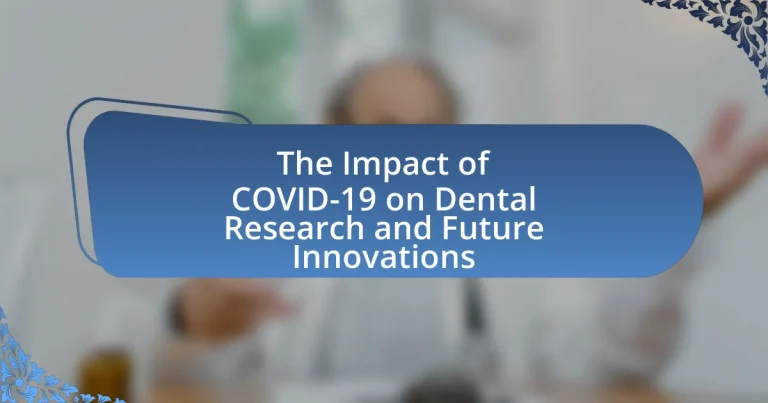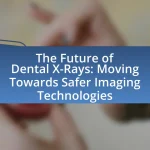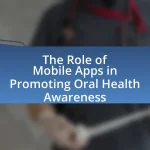The article examines the significant impact of COVID-19 on dental research, highlighting shifts in focus towards infection control, tele-dentistry, and the psychological effects on dental professionals and patients. It discusses how the pandemic has altered research priorities, increased funding challenges, and introduced barriers to collaboration. Key areas affected include the study of oral manifestations of COVID-19 and the development of innovative technologies in dental practices. The article also explores future trends in dental research and innovations, emphasizing the importance of adaptability and patient-centered approaches in shaping the post-pandemic landscape of dental care.
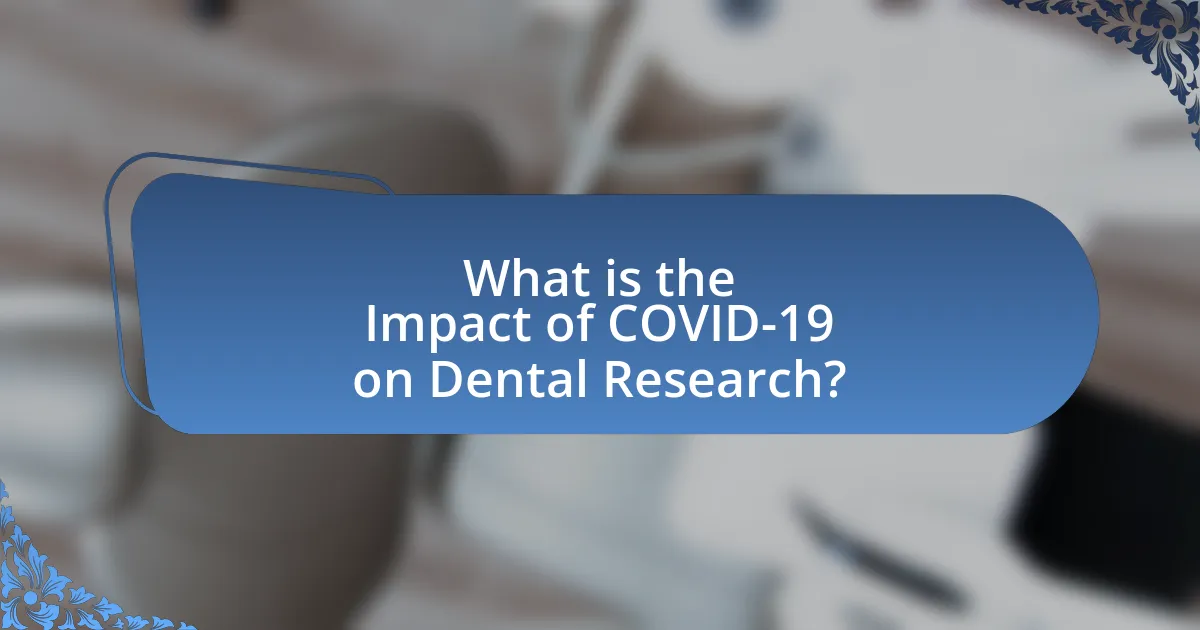
What is the Impact of COVID-19 on Dental Research?
The impact of COVID-19 on dental research has been significant, leading to a shift in focus towards infection control, tele-dentistry, and the psychological effects of the pandemic on patients and practitioners. Research has increasingly emphasized the need for enhanced safety protocols in dental practices, as evidenced by studies highlighting the heightened risk of aerosol transmission in dental settings. Additionally, the pandemic accelerated the adoption of tele-dentistry, allowing for remote consultations and follow-ups, which has been documented in various studies as a viable alternative to in-person visits during lockdowns. Furthermore, research has explored the mental health implications for dental professionals, revealing increased levels of anxiety and stress due to the pandemic’s challenges.
How has the pandemic altered the landscape of dental research?
The pandemic has significantly altered the landscape of dental research by accelerating the adoption of tele-dentistry and enhancing the focus on infection control protocols. Research efforts have shifted towards understanding the implications of COVID-19 on oral health, with studies highlighting the increased risk of oral manifestations in infected patients. For instance, a study published in the Journal of Dental Research in 2021 found that patients with COVID-19 exhibited a higher prevalence of periodontal disease, prompting researchers to explore the relationship between systemic health and oral conditions. Additionally, funding and resources have increasingly been directed towards developing innovative technologies and treatments that address both dental care delivery and patient safety in a post-pandemic world.
What specific areas of dental research have been affected by COVID-19?
COVID-19 has significantly affected areas of dental research, particularly in infection control, tele-dentistry, and the study of oral manifestations of the virus. Infection control research has intensified due to the need for enhanced safety protocols in dental settings, as evidenced by guidelines issued by organizations like the CDC and WHO. Tele-dentistry has gained prominence as a means to provide care while minimizing physical contact, leading to studies on its effectiveness and implementation. Additionally, research into the oral manifestations of COVID-19, such as taste disorders and periodontal implications, has emerged, highlighting the virus’s impact on oral health.
How have research priorities shifted during the pandemic?
Research priorities have shifted significantly during the pandemic, with a heightened focus on understanding COVID-19’s implications for oral health and dental practices. This shift is evidenced by an increase in studies examining the virus’s transmission in dental settings, the development of infection control protocols, and the impact of the pandemic on patient access to dental care. For instance, a systematic review published in the Journal of Dental Research in 2021 highlighted the urgent need for research on aerosol-generating procedures and their risks, reflecting the immediate concerns of dental professionals during the health crisis.
What challenges have researchers faced during COVID-19?
Researchers have faced significant challenges during COVID-19, primarily due to restrictions on in-person interactions and the prioritization of healthcare resources for pandemic response. These challenges included disruptions in ongoing studies, limited access to laboratories, and difficulties in recruiting participants for clinical trials. For instance, many dental research projects were halted or delayed as dental practices closed or operated under strict guidelines, impacting data collection and analysis. Additionally, funding for research was redirected towards COVID-19-related studies, further complicating the financial landscape for ongoing dental research initiatives.
How has funding for dental research been impacted?
Funding for dental research has significantly decreased due to the COVID-19 pandemic. According to a survey conducted by the American Dental Association in 2020, nearly 60% of dental researchers reported funding cuts or delays in their projects as a direct result of the pandemic. This decline in funding has hindered ongoing research initiatives and slowed the pace of innovation in the field, impacting the development of new treatments and technologies.
What barriers to collaboration have emerged due to the pandemic?
The pandemic has introduced significant barriers to collaboration in dental research, primarily due to restrictions on in-person interactions and travel limitations. These restrictions have hindered researchers’ ability to conduct joint studies, share resources, and engage in face-to-face discussions, which are crucial for effective collaboration. Additionally, the shift to remote work has created challenges in communication and coordination among research teams, leading to delays in project timelines and reduced productivity. According to a survey conducted by the American Dental Association in 2021, 70% of dental researchers reported that the pandemic negatively impacted their collaborative efforts, highlighting the widespread nature of these barriers.
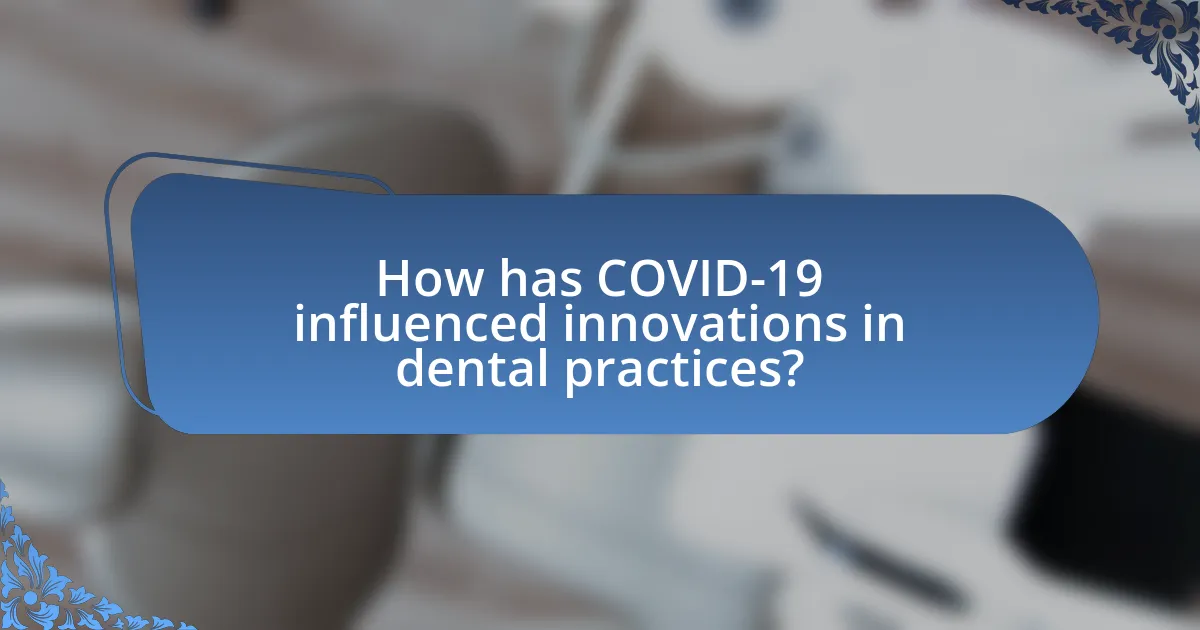
How has COVID-19 influenced innovations in dental practices?
COVID-19 has significantly influenced innovations in dental practices by accelerating the adoption of tele-dentistry and enhancing infection control protocols. The pandemic prompted dental professionals to implement virtual consultations, allowing patients to receive preliminary assessments remotely, which increased accessibility and reduced the risk of virus transmission. Additionally, practices adopted advanced sterilization technologies, such as UV light disinfection and air purification systems, to ensure a safer environment for both patients and staff. According to a study published in the Journal of Dental Research, 70% of dental practices reported an increase in the use of digital tools and technologies during the pandemic, highlighting a shift towards more innovative and efficient care delivery methods.
What new technologies have emerged in response to the pandemic?
Telehealth and teledentistry technologies have emerged significantly in response to the pandemic. These technologies enable remote consultations and diagnostics, allowing dental professionals to provide care while minimizing in-person visits. According to a study published in the Journal of Dental Research, the adoption of teledentistry increased by over 50% during the pandemic, demonstrating its effectiveness in maintaining patient care and safety. Additionally, advancements in sterilization technologies, such as UV-C light disinfection and air purification systems, have been implemented in dental practices to enhance infection control measures. These innovations reflect the dental industry’s adaptation to the challenges posed by COVID-19, ensuring continued patient access to care while prioritizing safety.
How have tele-dentistry and virtual consultations changed patient care?
Tele-dentistry and virtual consultations have significantly transformed patient care by enhancing accessibility and convenience for dental services. Patients can now receive timely consultations without the need for in-person visits, which is particularly beneficial for those in remote areas or with mobility issues. A study published in the Journal of Dental Research indicated that tele-dentistry increased patient engagement and satisfaction, with 70% of participants reporting a positive experience. Furthermore, virtual consultations have allowed dental professionals to triage cases effectively, reducing unnecessary office visits and minimizing the risk of COVID-19 transmission. This shift has led to a more efficient use of resources and improved overall patient outcomes in dental care.
What innovations in infection control have been developed?
Innovations in infection control that have been developed include advanced personal protective equipment (PPE), enhanced sterilization techniques, and the use of antimicrobial surfaces. Advanced PPE, such as N95 respirators and face shields, significantly reduce the transmission of pathogens in healthcare settings. Enhanced sterilization techniques, including the use of ultraviolet (UV) light and hydrogen peroxide vapor, have been shown to effectively eliminate viruses and bacteria on surfaces and instruments. Additionally, antimicrobial surfaces made from materials like copper and silver have been integrated into healthcare environments to inhibit microbial growth, thereby reducing the risk of infection. These innovations have been crucial in improving safety protocols, particularly in response to the COVID-19 pandemic, as evidenced by studies highlighting their effectiveness in reducing infection rates in dental and medical practices.
How are dental practices adapting to new health guidelines?
Dental practices are adapting to new health guidelines by implementing enhanced infection control measures and utilizing telehealth services. These adaptations include the use of personal protective equipment (PPE), improved sterilization protocols, and the installation of air filtration systems to reduce airborne pathogens. According to the American Dental Association, practices have reported a significant increase in the use of telehealth consultations, allowing for initial assessments and follow-ups without in-person visits, thereby minimizing potential exposure to COVID-19. Additionally, many dental offices are adopting contactless payment systems and online appointment scheduling to streamline operations while adhering to social distancing guidelines.
What changes have been made to patient management protocols?
Changes to patient management protocols include the implementation of enhanced infection control measures, such as the use of personal protective equipment (PPE) for dental staff and the adoption of pre-appointment screening for COVID-19 symptoms. These protocols have been established to minimize the risk of virus transmission during dental procedures. For instance, the American Dental Association recommends that dental practices conduct temperature checks and health questionnaires prior to patient visits, which has become a standard practice to ensure patient safety. Additionally, the use of high-efficiency particulate air (HEPA) filters in treatment areas has been integrated to improve air quality and reduce airborne pathogens, further supporting the safety of both patients and dental professionals.
How are dental professionals being trained for new practices?
Dental professionals are being trained for new practices through enhanced online education, simulation-based training, and updated clinical guidelines. The COVID-19 pandemic accelerated the adoption of virtual learning platforms, allowing dental professionals to access courses on infection control, tele-dentistry, and new technologies remotely. For instance, the American Dental Association has developed resources and webinars focusing on best practices during the pandemic, ensuring that dental professionals stay informed about evolving protocols. Additionally, simulation training has become more prevalent, enabling practitioners to practice new techniques in a controlled environment, which is crucial for adapting to changes in patient care and safety standards.
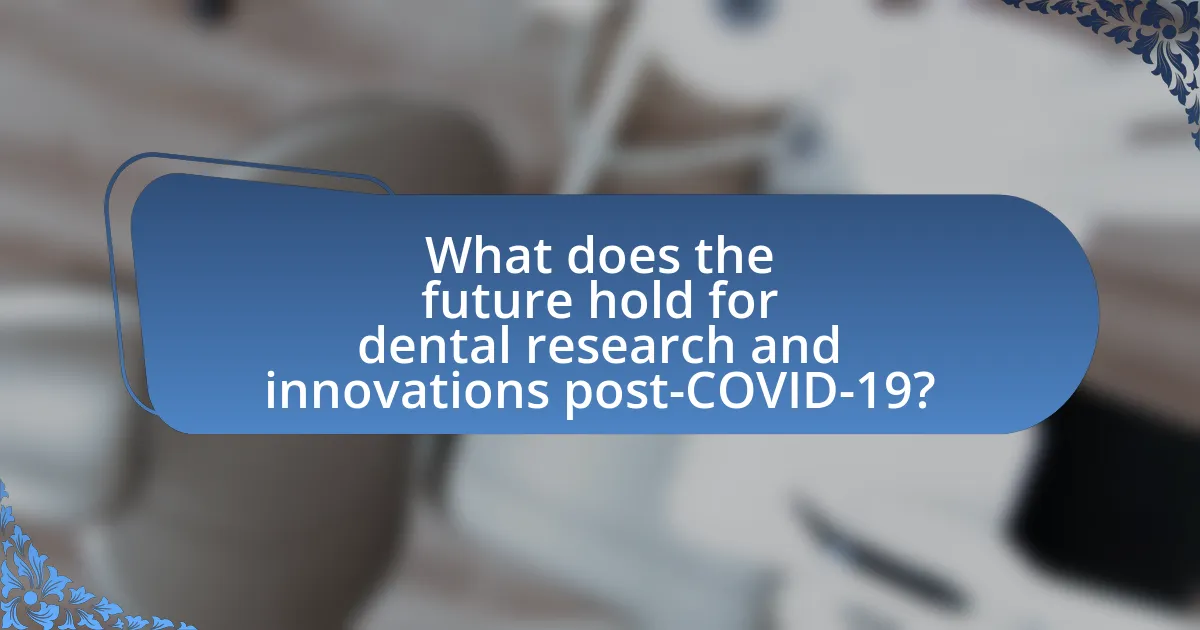
What does the future hold for dental research and innovations post-COVID-19?
The future of dental research and innovations post-COVID-19 is expected to focus on enhanced infection control measures, tele-dentistry, and advancements in materials and technology. Research will likely prioritize the development of safer dental practices and protocols to minimize the risk of virus transmission, as evidenced by the increased emphasis on aerosol management and personal protective equipment in dental settings. Additionally, tele-dentistry is anticipated to expand, facilitating remote consultations and follow-ups, which can improve access to care and patient management. Innovations in dental materials, such as antimicrobial coatings and biocompatible materials, are also expected to gain traction, driven by the need for safer and more effective treatment options. These trends reflect a broader shift towards integrating technology and safety in dental care, influenced by the lessons learned during the pandemic.
How will the lessons learned during the pandemic shape future research?
The lessons learned during the pandemic will significantly shape future dental research by emphasizing the importance of rapid response and adaptability in research methodologies. For instance, the pandemic highlighted the need for research that can quickly address emerging health crises, leading to the development of more flexible study designs and faster data collection methods. Additionally, the increased focus on telehealth and remote patient monitoring during the pandemic will likely drive future research towards integrating technology in dental practices, as evidenced by a surge in studies exploring the efficacy of virtual consultations and digital diagnostics. This shift is supported by data showing that telehealth usage in dentistry increased by over 150% during the pandemic, indicating a lasting change in how dental care may be delivered in the future.
What long-term changes can we expect in dental research funding?
Long-term changes in dental research funding are expected to include increased investment in tele-dentistry and digital health technologies. The COVID-19 pandemic has accelerated the adoption of these technologies, leading funding agencies to prioritize research that enhances remote patient care and improves access to dental services. For instance, the National Institutes of Health (NIH) has shifted some of its funding towards projects that explore the efficacy of virtual consultations and AI-driven diagnostics in dentistry, reflecting a broader trend towards integrating technology in dental practices. Additionally, there is a growing emphasis on interdisciplinary research that combines dental health with public health initiatives, as evidenced by increased grants aimed at understanding the oral-systemic health connection, which has gained attention during the pandemic.
How might collaboration in dental research evolve after COVID-19?
Collaboration in dental research is likely to evolve towards increased digital communication and interdisciplinary partnerships post-COVID-19. The pandemic has accelerated the adoption of telehealth and virtual collaboration tools, enabling researchers from different geographical locations to work together more efficiently. For instance, a study published in the Journal of Dental Research in 2021 highlighted that remote collaboration tools improved research productivity during the pandemic, suggesting that these practices will continue to be utilized. Additionally, the need for rapid responses to public health challenges, as seen during COVID-19, may foster stronger alliances between dental researchers and public health organizations, enhancing the focus on preventive care and community health initiatives.
What are the potential future innovations in dental care?
Potential future innovations in dental care include advancements in teledentistry, artificial intelligence for diagnostics, and 3D printing for custom dental solutions. Teledentistry allows for remote consultations, improving access to care, especially post-COVID-19, as evidenced by a 2021 study showing a 50% increase in telehealth visits in dentistry. Artificial intelligence can enhance diagnostic accuracy, with algorithms capable of analyzing radiographs and identifying issues faster than traditional methods. Additionally, 3D printing technology is revolutionizing the production of dental implants and aligners, reducing costs and improving patient outcomes, as demonstrated by a 2020 report highlighting a 30% reduction in production time for dental appliances.
How might advancements in technology further enhance dental practices?
Advancements in technology can significantly enhance dental practices by improving diagnostic accuracy, treatment efficiency, and patient experience. For instance, the integration of artificial intelligence in diagnostic imaging allows for more precise identification of dental issues, leading to better treatment outcomes. A study published in the Journal of Dental Research found that AI algorithms can outperform human dentists in detecting cavities and other dental anomalies, demonstrating a potential reduction in diagnostic errors. Additionally, the use of teledentistry has expanded access to care, allowing patients to consult with dental professionals remotely, which became particularly vital during the COVID-19 pandemic. This technology not only streamlines patient management but also reduces the risk of virus transmission in clinical settings. Furthermore, advancements in 3D printing technology enable the rapid production of dental prosthetics and aligners, significantly reducing wait times for patients. Overall, these technological innovations are reshaping dental practices by enhancing efficiency, accuracy, and accessibility.
What role will patient feedback play in shaping future innovations?
Patient feedback will play a crucial role in shaping future innovations in dental research by providing insights into patient needs and preferences. This feedback can guide the development of new treatments, technologies, and care models that are more aligned with patient expectations. For instance, studies have shown that incorporating patient perspectives can lead to improved satisfaction and adherence to treatment plans, ultimately enhancing health outcomes. Additionally, during the COVID-19 pandemic, patient feedback has highlighted the importance of telehealth and remote consultations, prompting innovations in digital health solutions tailored to patient convenience and safety.
What best practices can dental researchers adopt moving forward?
Dental researchers can adopt best practices such as enhancing collaboration across disciplines, prioritizing telehealth integration, and focusing on patient-centered research methodologies. Enhanced collaboration can lead to innovative solutions, as evidenced by the increased partnerships formed during the COVID-19 pandemic, which facilitated rapid sharing of data and resources. Prioritizing telehealth integration allows researchers to adapt to changing patient needs and improve access to care, as demonstrated by the significant rise in telehealth consultations during the pandemic. Lastly, focusing on patient-centered research methodologies ensures that studies address real-world challenges faced by patients, which is crucial for developing effective interventions and improving health outcomes.
How can researchers ensure resilience in future studies?
Researchers can ensure resilience in future studies by adopting flexible methodologies and integrating adaptive designs that can respond to unforeseen challenges. For instance, the COVID-19 pandemic highlighted the need for remote data collection methods, such as telehealth consultations, which allowed dental researchers to continue their work despite restrictions. Additionally, incorporating diverse funding sources and collaborative networks can enhance resource availability and support innovative approaches, as evidenced by the increased collaboration among institutions during the pandemic to share data and resources. This adaptability not only mitigates risks but also fosters a culture of innovation, essential for advancing dental research in unpredictable environments.
What strategies can be implemented to foster collaboration in dental research?
To foster collaboration in dental research, establishing interdisciplinary partnerships is essential. These partnerships can include collaborations between dental professionals, researchers, and institutions, which enhance the sharing of knowledge and resources. For instance, the integration of technology and data analytics in dental research has been shown to improve outcomes and innovation, as evidenced by studies highlighting the effectiveness of collaborative networks in advancing research initiatives. Additionally, creating platforms for regular communication, such as webinars and joint conferences, can facilitate ongoing dialogue and idea exchange among researchers, further driving collaborative efforts.
